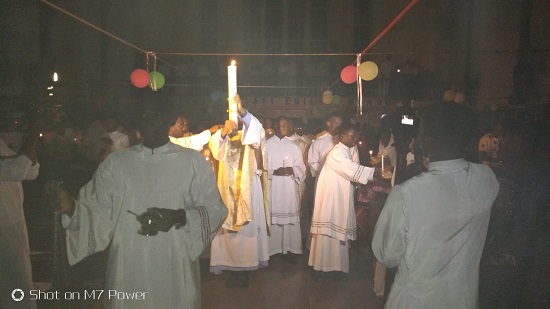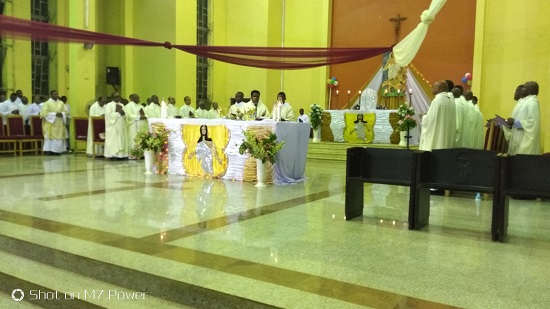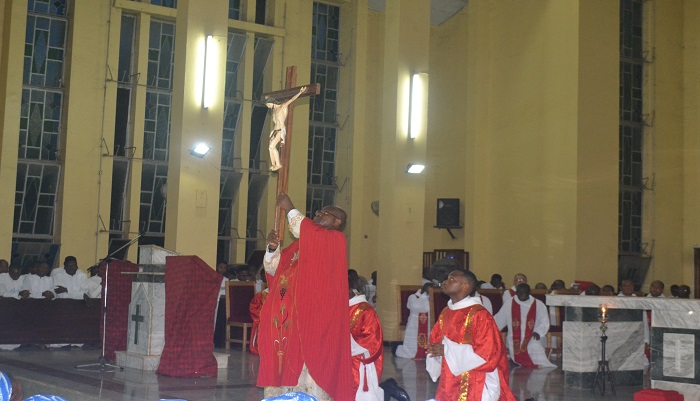Holy Thursday
On Thursday the 18th of April, 2019, the Bigard Family commenced the celebrations of the Triduum. The event began with the singing of the Office of the Readings and Lauds which started at exactly 06:00 hours. Later that morning, all the seminarians and Formators headed for the Holy Ghost Cathedral, Enugu, for the Chrism Mass which commenced at 10:00 hours. The Mass was presided over by his Lordship, Most Rev Callistus Onaga, the Catholic Bishop of Enugu Diocese. Most of the priests of Enugu diocese also came to be part of the celebration. Present also at the Mass were the Auxiliary Bishop of Enugu, Most Rev Ernest Obodo and the Emeritus Bishop of Enugu, Most Rev Anthony Gbuji. In his inspiring and soul searching homily, Bishop Callistus drew the attention of the people of God to the fact that the Chrism Mass is necessary for the Church in order to revalidate the essence and the import of the catholic priesthood. He also went further to admonish priests to always do their best to make every Mass a new one just like Cardinal Henry Newman did during his life time. His Lordship warned the priests against unnecessary quest for fame and popularity by charging them to be Christ-like and focused in their ministry. In his words, “it is not the position a priest holds in the Church that counts, but rather how fulfilled one is as another Christ”. He concluded with what Paul said in Romans 12:2: “do not model your behavior according to the contemporary world but let the renewal of your lives transform you so that you may discern for yourselves what is the will of God, what is good, acceptable and mature”.
After the homily, the next event was the renewal of priestly promises by the priests. This was followed by the blessing of the Chrism Oil, Oil for Catechumens, and Oil for Anointing of the Sick. The Books of Elect were thereafter presented by the catechumens. This was followed by the normal order of the Mass beginning with the offertory.

The second phase of the Holy Thursday celebration was the Evening Mass of the Lord’s Supper celebrated at the Bigard Main Chapel. The solemn event began at 17:00 hours and was presided over by the Pater familias of the house, Very Rev. Fr. Dr. Albert Ikpenwa in concelebration with the rest of the Formators and other priests who came to be part of the celebration. In his homily, the Rector applied both orthodoxy and orthopraxis in his homiletic approach. He began by drawing attention to the threefold nature of the evening’s event: the institution of the Holy Eucharist, institution of the Holy Priesthood and the promulgation of Love. His homily was anchored in one of the articles in the Missio Magazine titled “Life of Pain”. In that article, it was stated that in 2018, 35 priests were killed six of whom were Nigerians. These priests were killed either during the celebration of the Eucharist or while protecting the refugees in Central African Republic, in any case on their duty post. Reflecting on this, the Rector agrees with the Holy Father Pope Francis, that we have more martyrs now than in the 3rd century. The priests who were martyred gave up their lives because they were carrying out the injunction of Christ to “do this in memory of me” which demanded the sacrifice of their comfort and ultimately their very lives. Unfortunately, he said, people are beginning to neglect the power and the effects of the Eucharist. Christians today prefer to go to places where they can shout like the worshippers of Baal instead of sticking to the Catholic tradition. Furthermore, Fr. Rector noted that some priests are not helping matters as they aid in mutilating the Eucharist thereby leaving the faithful more distracted than they were. He, however, enjoined priests to celebrate the Eucharist according to the mind of the Church whether welcome or unwelcome and not to seek ways to do it according to their whims and caprices. He further noted that the significance of the Eucharist must be lived out in our daily lives.
Turning to the situation of the country, the homilist noted with passion that Nigeria is the way she is today because no one is ready to sacrifice for the good of others. Even the public servants are just servants of themselves and not the public. He also condemned the high rate of bribery and corruption that has eaten deep like a cankerworm into the very fabric of our country. In his words, “it is easier to cut corners and to seek what we want at all costs in Nigeria…”
In the end, he enjoined all present to take a stand in the society and to be ready to practice the spirit of sacrifice as Christ did. He also encouraged the people of God to pray for their priests and vice versa so that all can embrace the new life and be willing to lay down our lives for the human family and for the salvation of all.

After the homily, the washing of the feet followed suit. A total of 12 persons were selected across seminarians, lay staff, and the guests and were seated on 12 seats set for them in front of the altar, where the Rector stooped and washed their feet after the example of Christ.

The Mass thereafter proceeded in the traditionally way. After the post-communion prayer, the Sanctissimum was transferred from the altar of celebration to the altar of repose. At the altar of repose, benediction songs were rendered. After the order of the holy watch was announced, the chief celebrant and the concelebrating ministers returned to the sanctuary and stripped the altar. They, thereafter, departed in grave silence. Other faithful left the chapel in like manner as the group whose turn it was to keep watch stayed put.

Good Friday
The Good Friday celebration began with Via Crucis at 15:00 hours. The portraits of the different Stations of the Cross were carefully positioned at strategic positions beginning from Field B stretching to the front of the Bigard Main Chapel. The prayer was led by the second Dean of Administration, Rev. Fr. Anthony Okoye. It is to be remarked that as the words of the prayer at the different were being read, people acted them so passionately as to reenact the events that underlined the agonies of our Lord. Upon reaching the front the Bigard Main Chapel after the Last Station, the concluding prayer was said at the end of which the Lenten Fast Collection was made.

The celebration of the Lord’s Passion started at 17:00 hours. The liturgical ministers, dressed in red vestments, processed in utmost quiet and, upon reaching the altar, the principal celebrant and the two assisting deacons laid down before the stripped altar as the concelebrating priests, other ministers, and the faithful knelt down in a brief prayerful silence.

Taking his position at the left side of the sanctuary, he said the opening prayers that introduced the Liturgy of the Words. After the first and second readings taken from the Book of the Prophet Isaiah and the Letter to Hebrews respectively, there was the Passion Narrative according to St John. The wordings of the text were beautifully chanted by three deacons.

Explaining the readings in his homily, the principal celebrant, Rev. Fr. Dr. Ohajuobodo Okoemphasized that Jesus, as we already witnessed on Palm Sunday, entered Jerusalem in full knowledge of what awaited him – his passion. He also knew that his death would never be in vain. He knew he would follow the way of the cross and that through his Cross, he would glorify his Father who would in turn glorify him. He knew that when he would be lifted up, he would draw all to himself. Suffering, for Jesus, becomes, therefore, away to triumph over sin and death.
Considering the death of Jesus, he noted, one is almost always confronted with the question – who is responsible or who is to blame for the death ofJesus? Was it the Jews? Was it Judas? Pilate? Was it the soldiers? Was it the people for whose sins he died? Could it be, he wondered, that all these people could have been “divinely stage-managed” in order that God’s salvific plan could be brought to fruition? What would have been the case if those people had acted otherwise? Or could it be that Jesus, knowing the merits of his death, purposefully brought his own death by provoking the Jewish authorities? Who then is guilty?

To provide adequate answers to the above questions, the homilist explained, one needs to cast one’s look into the historical circumstances and inner motivations that underlined this mystery. Again, one necessarily needs to know how Jesus understood his death. What, one may ask, did God, whom Jesus called Father seek to achieve by allowing his death? What have we as Christian got to do with his death? On how Jesus understood his death, the homilist, quoting the Evangelist John, explained that Jesus understood himself as an emissary sent by God to lead humanity back to God. And so, his interest was to do the will of him who sent him. It was this self-understanding that was the crux of the misunderstanding between him and the Jewish authorities. His death is, therefore, a sign of hope and seal of love. It is with this understanding, he said, that one will appreciate the statement of Jesus that there is no greater love than this – that one lays down one’s life for his friends. For us, then, the death of Jesus is gain. The only thing that is required of us to die to sin and accept the salvation that Jesus has brought to us through his death.

The Veneration of the Cross was made immediately after the homily. The chief celebrant led in a procession from the entrance of the Bigard Main Chapel. He held up a veiled cross. Standing at the entrance, he unveiled the head of the cross with the words: “Ecce lignum…” and the people responded: “venite adoremus”. After a considerable interval, he unveiled the right arm of the cross repeating the words. He repeated the process again the third time unveiling the entire cross. On getting to the sanctuary, he laid the cross at the centre. He stooped and kissed the cross in veneration. Other priests did the same. Many lay faithful did likewise. On the account of large mass of people that were present for the celebration, the cross was raised for the rest to venerate the cross from their seats. But before this, the chief celebrant explained to the people why the alternative was necessary.
In the Prayers of the Faithful, prayers were said for people of all categories within the Christendom and without. At the beginning and end of each of the prayers, a deacon invited all the faithful to kneel and stand accordingly. In the end, there was a reception of Holy Communion after which the chief celebrant said the blessing of the people. At the end, the liturgical ministers processed into the sacristy in utter silence. The rest of the faithful also left the Church in silence.
Holy Saturday
The Vigil Celebration is divided into four parts, namely,
- A brief Service of the Light
- Liturgy of the Word
- Renewal of Baptismal Vows
- Liturgy of the Eucharist
At exactly 20:20 hours the commentator invited all to proceed to the entrance of the Bigard Main Chapel for the Service of the Light. Upon departure, all the light was put off save for the furnace burning outside of the chapel. After the ritual of the light, there was a procession back to the chapel. The procession was led by a deacon carrying the lighted Paschal Candle.

At a considerable interval, he raised the Paschal Candle singing the words lumen Christi (Light of Christ) and the people sang in response Deo gratias (thanks be to God). On reaching the altar, a deacon chanted the Exultet in Igbo.

At the conclusion of the Exultet, the Liturgy of the Word followed. Four readings were taken from the Old Testament. Thereafter, the Chief Celebrant, Rev. Fr. Dr. Mellitus Ossai intoned the Gloria in excelsis Deo after which the Collect was said. A reading was taken from the First Letter of St. Paul to the Romans before the Alleluia Chorus was sung, followed by the Gospel.
In his homily, Fr. Ossai stated that at Easter Vigil, the Church gathers to celebrate the joyful resurrection of our Lord Jesus Christ. Before the arrest of Jesus, his disciples followed him with pride, but after the death they scattered; the resurrection of Jesus influenced the apostles positively and renewed their hope. He further noted that it is not the death of Jesus that makes us believe in him, but his resurrection. If Christ had not resurrected, he would have been written off as an impostor. Similarly, as people charged with the task of furthering the Good News of Jesus Christ, people will believe us if there is no dichotomy between what we preach and profess, and what we actually practice in our daily lives. Enjoining the people to be proactive, he pointed out that Easter will have better impacts in our lives if we too can resurrect from our spiritual death.

After the homily, the congregation of believers renewed their baptismal promises with their lighted candles, after which the offertory procession commenced. The offertory collection ushered in the Liturgy of the Eucharist which was the last part of the celebration. After the reception of the Holy Eucharist and the post communion prayers, one of the formators, Rev. Fr. Osita Asogwa gave the vote of thanks. The chief celebrant, afterwards, gave the final blessing.
Easter Sunday
The Mass of the Resurrection of our Lord started at 7:30 hours and was presided over by Rev. Fr. Dr. Kevin Udenwagu. Other priests on the staff were also in attendance. People came from outside of the seminary to be part of the celebration and to witness the reception of Holy Communion by the first communicants.
The Readings of the Mass save for the Responsorial Psalm, were taken by two persons prepared from those to receive First Holy Communion. In his homily, anchored on a theme, Alleluia, Fr Kevin explained that alleluia simply means praise be the Lord and it is within the context of Easter that one will best appreciate its profound implications. The events of the tomb changed the narrative. Upon reaching the tomb and discovering that the stone had been rolled away and that Jesus is risen, the disciples started to understand the truth of what, all the while, had been hidden from them. They praised God. Jesus’ death started to acquire a profound salvific character. How then can the faithful bear witness to the risen Lord? It is by shouting all the more throughout the corners of the earth not just by words of mouth but through our lives.
There was sequence of thanksgivings by different groups. This was followed by consecration of gifts, and consequently, reception of Holy Communion, first of all, by candidates of First Holy Communion before others. After the post-communion prayer, the Vice Rector II, Very Rev. Fr. Dr. Francis Igboanugo gave a heartwarming vote of thanks through which he greeted all who have been actively involved in the events of the Holy weekend. He thanked specifically the principal celebrant of the Mass, Fr Kevin Udenwagu for the scholarship with which he approached his homily. Upon dismissal, there was a procession to the front of the Bigard Main Chapel for group photographs with the first Holy communicants.

